
Geldern is a city in the federal German state of North Rhine-Westphalia. It is part of the district of Kleve, which is part of the Düsseldorf administrative region. The nearby Dutch province of Gelderland is named after this city.
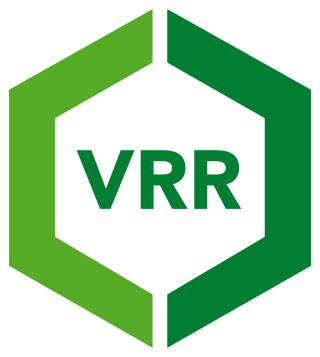
The Verkehrsverbund Rhein-Ruhr, abbreviated VRR, is a public transport association (Verkehrsverbund) in the German state of North Rhine-Westphalia. It covers most of the Ruhr area, as well as neighbouring parts of the Lower Rhine region, including Düsseldorf and thus large parts of the Rhine-Ruhr conurbation. It was founded on 1 January 1980, and is Europe’s largest body of such kind, covering an area of some 5,000 km2 (1,900 sq mi) with more than 7.8 million inhabitants, spanning as far as Dorsten in the north, Dortmund in the east, Langenfeld in the south, and Mönchengladbach and the Dutch border in the west.
Duisburg Hauptbahnhof is a railway station in the city of Duisburg in western Germany. It is situated at the meeting point of many important national and international railway lines in the Northwestern Ruhr valley.
Line S 11 is a S-Bahn line operated by DB Regio on the Rhine-Ruhr S-Bahn network. It connects Düsseldorf Airport Terminal with Bergisch Gladbach, running via Düsseldorf Neuss, Dormagen and Cologne. Before 13 December 2009, the service operated from Wuppertal-Vohwinkel in peak time, sharing the Wuppertal-Düsseldorf run with the S8 trains. Normal operation, though, started at Düsseldorf-Wehrhahn. Since the introduction of the new 2010 Schedule the service starts at Düsseldorf Airport Terminal replacing the line S 7 to Düsseldorf Hbf. The former run to Wuppertal-Vohwinkel is now conducted by the S 68.

Neuss Central Station is the railway station for the city of Neuss in the German state of North Rhine-Westphalia. The main station building is built on a platform between the tracks and it is located at the junction of the Lower Left Rhine Railway and the Mönchengladbach–Düsseldorf railway. These lines also connect with the Düren–Neuss railway and the Neuss–Viersen railway; the latter has ended since 1984 at Kaarster See station and is operated by the private Regiobahn company.

Krefeld Hauptbahnhof is the largest station of the city of Krefeld in the German state of North Rhine-Westphalia. The double-track and electrified Duisburg-Ruhrort–Mönchengladbach railway and the Lower Left Rhine Railway cross at the station.
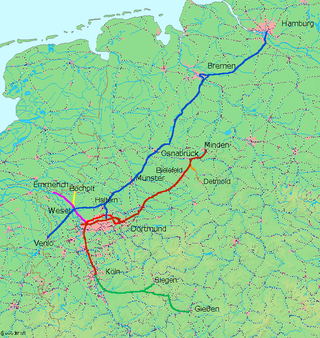
The 64 km long Cologne–Duisburg railway is one of the most important lines in Germany. It is the main axis for long distance and urban passenger rail services between Cologne and the Ruhr, served by Intercity Express, Intercity, Regional Express, regionalbahn and S-Bahn trains. It was the first section built of the Cologne-Minden trunk line and is one of the oldest railways in Germany. It was opened in 1845/46 and has been repeatedly modernized and expanded. Today the route comprises two or three double lines and is electrified throughout.
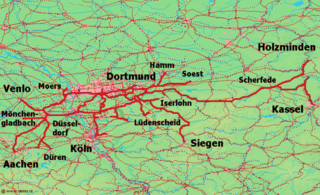
The Elberfeld–Dortmund railway is a major railway in the German state of North Rhine-Westphalia. It is part of a major axis for long distance and regional rail services between Wuppertal and Cologne, and is served by Intercity Express, InterCity, Regional Express, Regionalbahn and S-Bahn trains.

Köln-Mülheim is a railway station situated at Mülheim, Cologne in western Germany. It is served by several regional trains, the S6 and S11 lines of the Rhine-Ruhr S-Bahn and the 13 and 18 lines of Cologne Stadtbahn.
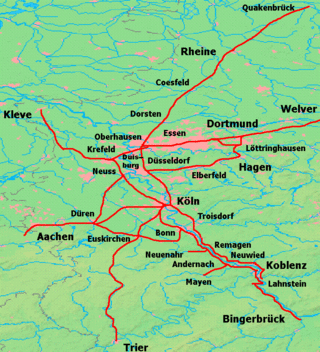
The Rhenish Railway Company was along with the Cologne-Minden Railway Company (CME) and the Bergisch-Märkische Railway Company (BME) one of the railway companies that in the mid-19th century built the first railways in the Ruhr and large parts of today's North Rhine-Westphalia.

The Duisburg-Ruhrort–Mönchengladbach railway is a historically significant, but now partly abandoned line in the German state of North Rhine-Westphalia. The line was built by the Ruhrort-Crefeld District Gladbach Railway Company, founded in 1847, and is one of the oldest lines in Germany, opened in 1849 and 1851.

The Aachen–Mönchengladbach railway is a main line in the German state of North Rhine-Westphalia. It is an important link between the Ruhr and Belgium for freight trains and is served by regional passenger trains. The line was built by the Aachen-Düsseldorf-Ruhrort Railway Company and is one of the oldest lines in Germany, which was opened between 1852 and 1854.
The Spyck–Welle train ferry was a train ferry on the Rhine between Spyck on the left (southern) bank and Welle on the right bank in the lower Rhine region of the German state of North Rhine-Westphalia. It was established in 1865 by the Rhenish Railway Company on the Lower Left Rhine line from Cologne to Neuss, Krefeld, Cleves, Elten, Zevenaar and the Dutch North Sea ports.
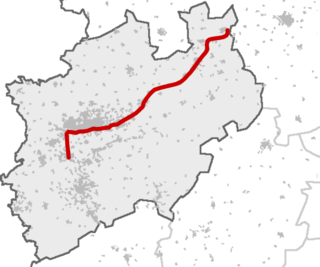
The Rhein Weser Express is a Regional-Express service route in the German state of North Rhine-Westphalia, connecting some of the most important cities in Westphalia with the Ruhr. Cologne, Neuss, Düsseldorf and Duisburg lie on the Rhine while Minden lies on the Weser.

The Neuss–Viersen railway is a mostly disused railway line in the German state of North Rhine-Westphalia. It formerly ran from Neuss via Kaarst and Neersen to Viersen, but now ends in Kaarst.

The Rhein-Münsterland-Express is a Regional-Express service in the German state of North Rhine-Westphalia (NRW). The hourly service initially runs to the south east from Krefeld via Neuss to Cologne and then turns to run to the northeast via Solingen, Wuppertal, Hagen to Münster. Every two hours it continues to Rheine.

The Rhein-Haard-Express is a Regional-Express service in the German state of North Rhine-Westphalia (NRW), running from Osnabrück via Münster, Recklinghausen, Gelsenkirchen, Essen and Duisburg to Düsseldorf.

The Osterath–Dortmund-Süd railway is a historically significant line in the German state of North Rhine-Westphalia. Parts of it are closed, much of it is now used for freight only, but several sections are still used for Regional-Express, Regionalbahn or Rhine-Ruhr S-Bahn services.

The Rheinhausen–Kleve railway, also known in German as the Niederrheinstrecke, is a formerly continuous railway on the Lower Rhine in the German state of North Rhine-Westphalia.

Kleve is a railway station in the town of Kleve, North Rhine Westphalia, Germany. The station opened on 5 March 1863 on the Lower Left Rhine Railway. The train services are operated by NordWestBahn.






















